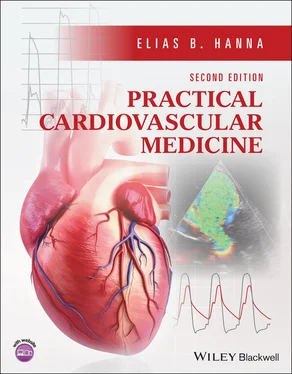10 Chapter 12Table 12.1 Electrocardiographic localization of the AP.
11 Chapter 13Table 13.1 Effect of atropine and exercise on AV block.Table 13.2 Differential diagnosis of a regular, non-tachycardic (<100 bpm) n...Table 13.3 Differential diagnosis of a regular, non-tachycardic wide complex...
12 Chapter 16Table 16.1 Differentiation of various mechanisms of arrhythmias.
13 Chapter 17Table 17.1 Comparison of hemodynamic findings in constrictive pericarditis, ...Table 17.2 The three most important recordings in the hemodynamic assessment...Table 17.3 Echocardiographic differentiation between constrictive pericardit...
14 Chapter 19Table 19.1 Differential diagnosis: arterial claudication, neurologic claudi...Table 19.2 Acute limb ischemia vs. critical limb ischemia.Table 19.3 Types of lower extremity ulcers.Table 19.4 Classification of PAD severity based on ABI.Table 19.5 Highlights of the TransAtlantic InterSociety Consensus (TASC) cl...Table 19.6 Management of lower extremity ulcers.Table 19.7 High-risk features for CEA and carotid stenting.Table 19.8 Signs of advanced renal parenchymal disease and signs of functio...
15 Chapter 20Table 20.1 Types of endoleaks.
16 Chapter 21Table 21.1 Risk factors for PE/DVT.Table 21.2 Duration of long-term anticoagulation.
17 Chapter 22Table 22.1 Hemodynamic findings in the four different types of shock.Table 22.2 Causes of cardiogenic shock.Table 22.3 General indications for transfusion in critically ill or ACS pat...
18 Chapter 23Table 23.1 Situations that warrant workup for secondary HTN. Table 23.2Causes of secondary hypertension. Table 23.3Basic workup for any HTN.Table 23.4 Specific workup when secondary HTN is suspected.Table 23.5 Treatment in specific settings.
19 Chapter 25Table 25.1 Classification of severity of pulmonary hypertension.
20 Chapter 26Table 26.1 Features that suggest seizure rather than syncope.Table 26.2 Clinical clues to the diagnosis of syncope. 2–5,8Table 26.3 ECG or rhythm monitor findings suggestive of cardiac syncope.Table 26.4 Types of response to tilt table testing.
21 Chapter 27Table 27.1 Causes of chest pain.Table 27.2 Causes of acute dyspnea.Table 27.3 Diagnostic features of palpitations (duration, onset/offset, reg...Table 27.4 Workup of palpitations.
22 Chapter 30Table 30.1 Echocardiographic features allowing the differential diagnosis o...Table 30.2 Cardiovascular drugs and pregnancy.
23 Chapter 31Table 31.1 Differential diagnosis of ST-segment depression and/or T-wave in...Table 31.2 Differential diagnosis of ST-segment elevation. Table 31.3 Localization of anterior MI.Table 31.4 Differentiate RCA from LCx in inferior MI.
24 Chapter 32Table 32.1 Severe valvular regurgitation.Table 32.2 Severe valvular stenosis: severe AS, including low-gradient AS, a...Table 32.3 Pitfalls of E/E’ in the evaluation of LA pressure.Table 32.4 Beside the occluder profile, four causes of pressure gradient acr...Table 32.5 Echocardiographic differentiation between a physiologically high ...Table 32.6 Echocardiographic differentiation between a physiologically high ...
25 Chapter 33Table 33.1 Clinical probability of CAD.Table 33.2 Standard Bruce treadmill protocol.Table 33.3 High-risk stress ECG and Duke Treadmill Score (DTS).Table 33.4 Sensitivity and specificity of various stress testsTable 33.5 Risk stratification with stress testing.Table 33.6 Indications to stop the stress test.Table 33.7 Factors that reduce the sensitivity and specificity of any stress...
26 Chapter 36Table 36.1 Correlation between LVEDP and mean PCWP.Table 36.2 Fick equation.Table 36.3 Normal exertional values of PCWP, PA pressure, and cardiac outpu...
27 Chapter 38Table 38.1 Risk factors for stent thrombosis.Table 38.2 Recurrent target vessel disease/angina after stenting.Table 38.3 Peri-PCI antithrombotic therapy.Table 38.4 Causes of lack of appropriate pressure augmentation.
1 Chapter 1 Figure 1.1 Diagnosis and types of myocardial infarction. Figure 1.2 Kinetics of troponin release. Troponin rises above MI cutoff at 2... Figure 1.3 0/1-hour or 0/2-hour ESC algorithm using hs-troponinin patients ... Figure 1.4 Platelet receptors and antiplatelet mechanisms of action. Cycloo ... Figure 1.5 Specific effects of the four anticoagulants.A heparin derivativ... Figure 1.6 Summary of anticoagulant use in NSTE-ACS, before catheterization ... Figure 1.7 Duration of dual antiplatelet therapy (DAPT) according to ACC gui... Figure 1.8 Antiplatelet therapy after PCI in patients who also require antic... Figure 1.9 The concentric and eccentric lesions with smooth borders are pred... Figure 1.10 NSTEMI in a healthy 47-year-old woman. Chest pain started during...
2 Chapter 2 Figure 2.1 Phases of STEMI.Phase 3 does not imply that MI has already been... Figure 2.2 The patient presents with chest discomfort that has lasted 3 hour... Figure 2.3 Fibrinolysis cascade and mechanism of action of fibrinolytics. Fi... Figure 2.4 The timing of PCI in relation to thrombolysis in the pharmacoinva... Figure 2.5, Stages of negative LV remodeling post-MI, also called infarct ex... Figure 2.6 Dynamic left ventricular outflow tract obstruction in apical infa... Figure 2.7 LV aneurysm and LV pseudoaneurysm.In comparison with the normal...
3 Chapter 3 Figure 3.1 Clinical probability of CAD. Figure 3.2 Proposed diagnostic approach to chronic chest pain. Note that CTA...
4 Chapter 4 Figure 4.1 Diagnosis of HFpEF by catheterization, echo, or BNP features, acc... Figure 4.2 Diagnosis of HFpEF in subtle cases of dyspnea with no overt conge... Figure 4.3 Change of LV filling pattern between compensated and decompensate... Figure 4.4 ( Top ) The worsening of a resting defect is indicative of ischemia... Figure 4.5 Case of chronic HF with LV dilatation and mild increase in PCWP.... Figure 4.6 Diuretic response in a normal individual and in HF. Note that no ... Figure 4.7 Hemodynamic decompensation starts several weeks before clinical d... Figure 4.8 Effect of HF on renal blood flow and GFR. Renal blood flowis aff... Figure 4.9 Mechanisms through which diuresis and inotropes initiate a benefi... Figure 4.10 Septal motion and LV-RV interdependence in various disease state...
5 Chapter 5Figure 5.1 Diagnosis of amyloid cardiomyopathy. If both tests are positive, ...Figure 5.2 Simultaneous LA and LV pressure recordings in diastole. Normal...Figure 5.3 Cardiac output–preload relationship (Frank–Starling curve = lengt...Figure 5.4 Force (afterload)- velocity relationship.The failing LV is exqui...Figure 5.5 Compliance curve, i.e., pressure–volume relationship in diastole....Figure 5.6 Important HF figure, showing a diastolic superimposition of the F...Figure 5.7 Pressure-volume loopsNormal individuals, with pressure–volume...
6 Chapter 6Figure 6.1 (a)Illustration of a horizontal cut across the mitral plane on t...Figure 6.2 Carpentier’s classification of the mechanisms of mitral regurgita...Figure 6.3 Mitral valve prolapse. The long-axis view defines prolapse, while...Figure 6.4 Illustration of ischemic MR on longitudinal views. (a)Normal val...Figure 6.5 (a)Horizontal cut across the mitral valve. Normal structure of t...Figure 6.6 Atrial functional MR vs LV functional MR.In atrial functional MR...Figure 6.7 Difference in V wave and LV diastolic pressure between (1) chroni...Figure 6.8 Unlike (a), the chordae are tied to the mitral annulus before imp...Figure 6.9 Difference between rheumatic MS and MAC MS.In rheumatic MS, the ...Figure 6.10 (a)Long-axis view in diastole. See the hockeystick shape of the...Figure 6.11 Two examples of mitral stenosis with a diastolic pressure gradie...Figure 6.12 False impression of MS resulting from the use of PCWP as a surro...Figure 6.13 Illustration of the difference between rheumatic MS and MAC-MS....Figure 6.14 β-blockers slow the heart rate and allow more LA emptying, which...Figure 6.15 Aortic leaflets and their relation to the ascending aorta. A nor...Figure 6.16 1.In acute AI, LV volume is normal and the regurgitant volume l...Figure 6.17 (a)Difference in aortic orifice shape between the tricuspid and...Figure 6.18 Left image- Axial cut of the LVOT, which is elliptical rather th...Figure 6.19 Peak-to-peak gradientis the difference between the two peaks ( h ...Figure 6.20 Pressure recovery phenomenon.Pressure (potential or static ener...Figure 6.21 TAVR valves and relation to the coronary ostia.TAVR valves cons...Figure 6.22 Normal tricuspid anatomy as viewed from the RA (surgeon’s view)...Figure 6.23 The tricuspid valve is normally oval-shaped in a horizontal plan...Figure 6.24 Repair of functional TR:(i) Kay bicuspidization: plication of ...Figure 6.25 Prosthetic valves. Surgical bioprostheses typically contain meta...Figure 6.26 Left image- Bioprosthetic valve as seen on fluoroscopy. The ring...Figure 6.27 Choice of a mechanical prosthesis vs. bioprosthesis vs TAVR, acc...Figure 6.28 Figure 6.29 Figure 6.30 Figure 6.31
Читать дальше












